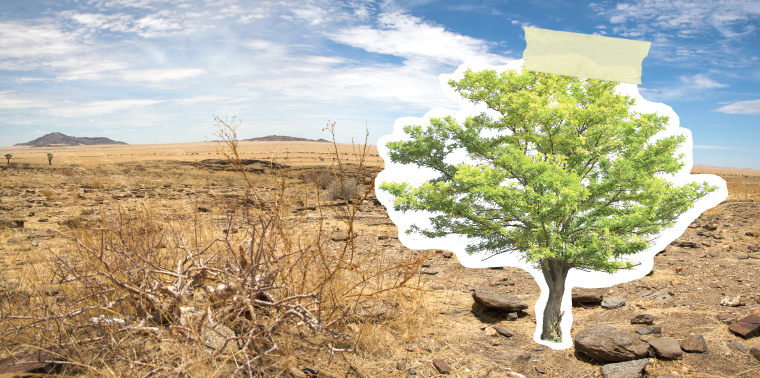April 20, 2011 — The view from space offers a clarity about our changing planet less visible from the ground: spring thaw coming sooner year after year, the iconic snows of Kilimanjaro and glaciers across the globe dwindling — and a great green wall of vegetation spreading across the region just south of Africa’s Sahara Desert.
This arid expanse, known as the Sahel, stretches from the Atlantic Ocean to the Red Sea. It has undergone a remarkable transformation since farmers in nations across the region began to allow trees to grow amidst their crops.
In some places it was by accident, as seeds sprouted from manure spread as fertilizer in Niger. In others it was by design, such as the “green dam” against the desert started in Algeria in 1971. But the result has been the same: improved harvests of millet, sorghum and other staple crops in a region gripped by perennial drought.
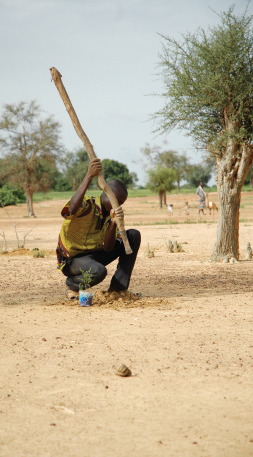
Tree-planting farmers in Africa’s Sahel region hope to make arid lands more productive in the face of perennial drought. Photo by ★ Tex ★ (Flickr/Creative Commons).
Such “agroforestry” boosts yields by returning vital nutrients to the soil in the form of decaying leaves, shading crops from the harshest sun, and recharging underground water reserves. The trees also provide an additional source of income: wood for fires and construction. And they have another even more important benefit: They may help some of the poorest farmers in the world adapt to climate change — while potentially removing as much as 50 billion metric tons of carbon dioxide from the atmosphere, according to agronomist Dennis Garrity, head of the Nairobi-based World Agroforestry Centre.
“The transformation of agriculture into agroforestry is well underway,” Garrity says. “Agricultural systems incorporating trees increase overall productivity and incomes in the face of more frequent droughts, and agroforestry systems provide much greater carbon offset opportunities than any other climate mitigation practice in agriculture.”
Climate change is already worse than anticipated by the U.N. Intergovernmental Panel on Climate Change. Extreme precipitation events, such as last spring’s flooding in Nashville, Tenn., or last winter’s drought in China, have become more frequent. Sea ice extents have reached record lows in the Arctic. And 2010 marked the end of the hottest decade in recorded history.
Whatever measures might be adopted to reduce emissions of greenhouse gases, the world will still need to adapt to a changing climate. Indeed, that process has already begun.
Not only that, but the 0.7-degree-Celsius uptick in global average temperatures we’ve seen so far is only half the warming that can be expected from the concentrations of greenhouse gases already in the atmosphere, according to a 2010 report from the U.S. National Research Council. And as warming continues, according to the NRC report, the world can expect (among other things) a drop in the yield of cereal crops due to higher temperatures, an increase in heavy rainfall and a rise in ocean levels.
In other words, whatever measures might be adopted to reduce emissions of greenhouse gases, the world will still need to adapt to a changing climate. Indeed, that process has already begun.
Climate Refugees
The Carteret Islands in the far southwestern Pacific are not on most maps of the Earth, too small to merit inclusion at just 1 square kilometer of total land mass spread among a cluster of coral atolls. But they just might make it big in the history books — as the (former) home of the world’s first true climate refugees.
“The Carterets lie in a circular reef infringed by many reefs in a lagoon, very beautiful but going down really fast through shorelines degradation,” reports Ursula Rakova, a local resident. “Over the last 20 years, [the] Carterets have been experiencing rising sea levels, and our chiefs got together and initiated an organization which could fast-track our relocation.”
The oceans rose roughly 2 millimeters per year over the course of the 20th century, creeping up the Carteret’s shores. The Carteret islanders may have made a bad situation worse by fishing with dynamite, destroying protective reefs in the quest for food after refugees flooded the islands during Bougainville’s war to secede from Papua New Guinea in the 1990s. But sea levels could rise meters more by this century’s end as warmer ocean waters expand and the meltdown of vast ice sheets in Greenland continues. That would be the end of the Carterets — and many other small islands.
The government of a more famous island chain, the Maldives, has announced efforts to set aside money that would allow its more than 300,000 citizens to secure a new homeland. But the 1,700 or so Carteret islanders may be among the first to actually move. That’s because scientists estimate the islands will be drowned by 2015.
A 19th century sea captain dubbed the Carterets “Massacre Islands.” The massacre now is of the traditional foodstuffs of the inhabitants: taro, breadfruit and the like, poisoned by intruding salt water that is also fouling drinking water. Storm surges — and even waves at high tide — now routinely wash over entire islands in the group.
“The sea that was once a friend to us is basically now destroying the lives of my people.” — Ursula Rakova
The Papua New Guinea government has authorized Carteret residents to move, and at least five families already have permanently relocated to Bougainville as part of what the islanders are calling Tulele Peisa, or “sailing the waves on our own.” The move is expected to take at least a decade to complete, according to Rakova, who is helping lead the relocation effort.
“The sea that was once a friend to us is basically now destroying the lives of my people,” she told OneWorldTV. “When we move it means some parts of our culture will be destroyed, will be left behind because we need to adapt to the new situation.”
Rising Waters
Sea level rise isn’t just affecting small islands. It is also altering lives in rich countries like the Netherlands. The Dutch decided in 2006 to come up with a long-term plan for coping with climate change. How long? Two hundred years long. The plan is set to cope with sea level rises of as much as 4 meters by the end of that span.
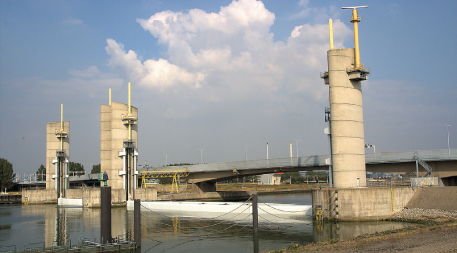
Storm surge barriers such as the Hartelkering in the Hartel Canal are part of the Netherlands’ strategy to stave off rising ocean waters. Photo by Quistnix! (Flickr/Creative Commons).
The Netherlands’ strategy covers everything from strengthening massive sea defenses, like the Delta Works series of dams and barriers, to planting trees to soak up CO2 while cooling Amsterdam and other cities. Massive dunes that protect the coast will be reinforced with dredged sand. Some land will be abandoned to rising sea levels — a managed retreat.
Part of the Netherlands is already below sea level, low-lying areas of, typically, farmland surrounded by dikes known as polders. To adapt to a world with both more intense periods of rainfall and longer droughts, the Dutch will need water storage, and that’s exactly what they will get by flooding these formerly drained areas. The essence of this part of the plan is summed up in its name, Planologische Kernbeslissing Ruimte voor de Rivier — “Space for the River.”
Certain communities that will remain drained will be designated as spillover zones to contain unusual floods. It’s as if New Orleans had designated the Ninth Ward as a place that would be flooded when faced with a powerful storm surge like the one created by Hurricane Katrina. Of course, that’s exactly what happened — but in an unplanned inundation that resulted in more than 1,400 deaths.
The Dutch are not alone. Communities from New Orleans to Kings County, Wash., are developing plans to deal with flooding — or at least strengthening levees in anticipation of new water flow conditions. And in January, the U.K. environment ministry released some of its suggested climate adaptation plans, including new standards for roads that will face hotter summer temperatures and even potentially relocating fish from waters in the famous Lake District of northwestern England to cooler waters further north.
Carbon Controls
Water is also a major concern when it comes to generating electricity. That’s because power plants that burn fossil fuels or split uranium atoms to produce turbine-turning steam need a lot of water to cool the steam once it’s done its job. As a result of droughts in the southeastern U.S. in 2007, some coal and nuclear power plants actually had to produce less electricity because there simply wasn’t enough water to do so.
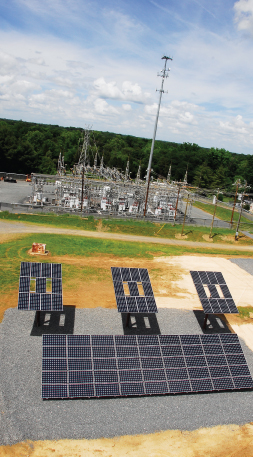
Conventional power generation uses tons of water. By installing solar photovoltaic panels and batteries to store the electricity they generate, Charlotte, N.C.–based Duke Energy is increasing the resilience of its grid to drought. Photo courtesy of Duke Energy.
That’s one of the reasons why electric utility Duke Energy — the third-largest CO2 emitter among U.S. corporations — is getting into solar energy. The power provider has installed photovoltaic panels in neighborhoods and on the rooftops of some of its larger customers, like a Food Lion grocery store in Salisbury, N.C.
“We paid the customer to allow us to use their roof as if it was a plant site,” explains Jim Rogers, chief executive of the Charlotte-based utility. “It is just another way of making electricity.”
It also happens to be a way of making electricity that produces less of the CO2 causing climate change. Such low-CO2 sources of electricity — whether solar or new nuclear power plants — are exactly what Rogers and some other utility executives see as the future of power in the U.S.
“It is very critical that we address the carbon issue,” Rogers says.
Betting on the Weather
Some companies are making money preparing for climate change — or, more specifically, the weather climate change will produce — via new weather derivatives.
Weather desks like the one at Evolution Markets in White Plains, N.Y., help companies buy and sell the weather — specifically, heating degree days in winter and cooling degree days in summer. “Degree days” measure the deviation from a temperature that would require no heating in winter or cooling in summer. The idea is to buffer, say, a brewery against the loss in beer sales occasioned by an unusually cool and damp summer — or, more commonly, an electric utility against the loss in revenue that stems from an unusually cool summer that requires fewer people to use electricity in running air conditioners.
The most obvious customers for such a product are farmers, given the loss in yields that may be occasioned by hotter summers. But one can even go so far as to take out futures contracts on the amount of snow that will fall in a given city, say New York or Chicago. Those who own the contracts receive a payout for every extra inch of snowfall above the average. Not a bad deal for the winter of 2010–11: The Windy City averages 38 inches of snow a winter — and just received more than 50 inches for the fourth straight year.
The idea is to prepare for disasters before they happen rather than simply respond to them afterwards.
Similarly, aid organizations such as the U.N. World Food Programme have bought insurance against climate change impacts. In 2006, the organization purchased insurance from AXA Re against the potential for catastrophic drought in Ethiopia. The policy stipulated that if rainfall dropped below a certain minimum amount, millions of dollars in insurance money would be paid out, in effect pre-funding the organization’s emergency response. Such “catastrophe bonds” have seen a sharp increase in use in the past year.
Preparing for the Future
Red Cross and Red Crescent societies move in when disaster strikes. According to their own analyses, the emergency aid organizations have seen a doubling of weather-related disasters since 1990. So the aid groups established a Climate Centre in 2002 to help them adapt to a world of more frequent catastrophe. The idea is to prepare for disasters before they happen rather than simply respond to them afterwards. So, for example, a simple action like regularly clearing storm drains can cut down on the damage caused by an unexpectedly heavy or long-lasting downpour.
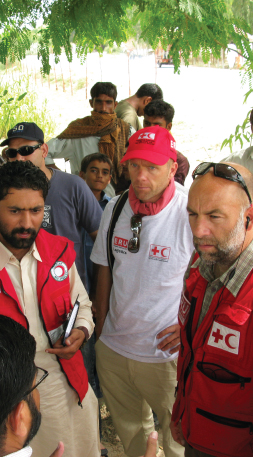
Buffeted by increasingly frequent weather-related disasters, the Red Cross and Red Crescent societies are increasing emphasis on preparing for catastrophe. Photo courtesy of British Red Cross.
Roughly $30 billion has been promised to fund adaptation efforts in the poorest countries going forward, as a result of last fall’s climate change negotiations in Cancun, Mexico. International financial organizations such as the World Bank have begun to make loans specifically tied to adapting to climate change. For example, “Climate Investment Funds” offer loans and grants to countries to fund adaptation efforts, such as building renewable energy projects or helping farmers adapt to new weather conditions. Such loans are not without controversy, though, since some view them as having people who had little to do with climate change to pay for its impacts.
The key is making sure that relevant actions are taken when the timing is appropriate.
In the end, the extent of the need to adapt to a warming world will depend on how much warming we choose to take on.
“Planting trees against increased flood risks is likely an excellent action in some regions to adapt to climate change-related risks, but it is not what you do when a hurricane is imminent,” says Maarten van Alst, lead climate specialist at the Red Cross’s Climate Centre. “And sea level rise is a serious threat for the Netherlands, but we do not start evacuating Amsterdam tomorrow.”
In the end, the extent of the need to adapt to a warming world will depend on how much warming we choose to take on. The average temperature of the planet for the next several thousand years will be determined this century by those of us living today. Changing our lifestyles to minimize the adaptation burden we bequeath to future generations may prove the biggest adaptation challenge of all.
As atmospheric scientist Susan Solomon of the National Oceanic and Atmospheric Administration says, comparing CO2 emissions to cheesecake: “If I knew that every pound of cheesecake that I ate would give me a pound that could never be lost, I think I would eat a lot less cheesecake.” ![]()
Ensia shares solutions-focused stories free of charge through our online magazine and partner media. That means audiences around the world have ready access to stories that can — and do — help them shape a better future. If you value our work, please show your support today.
Yes, I'll support Ensia!